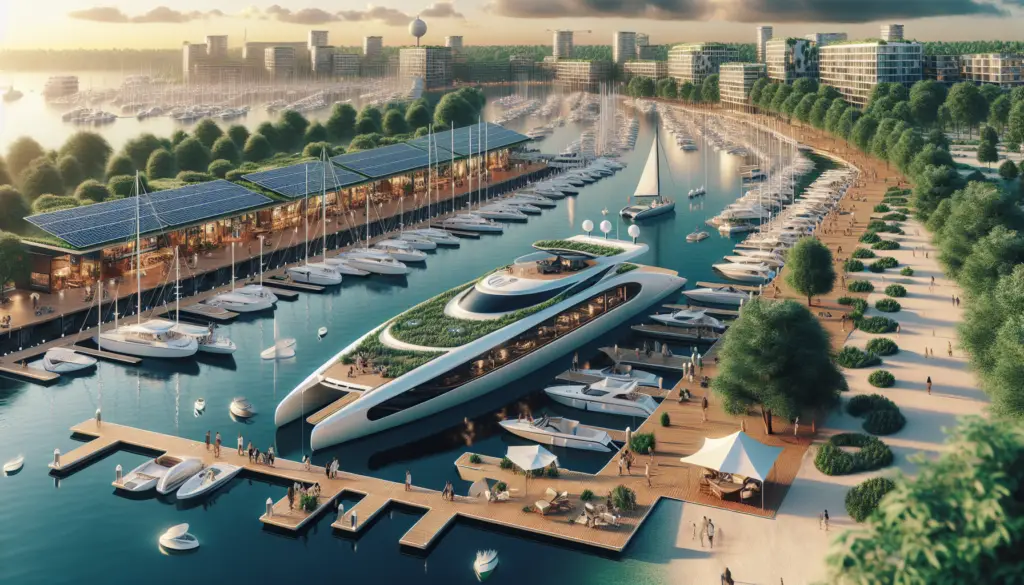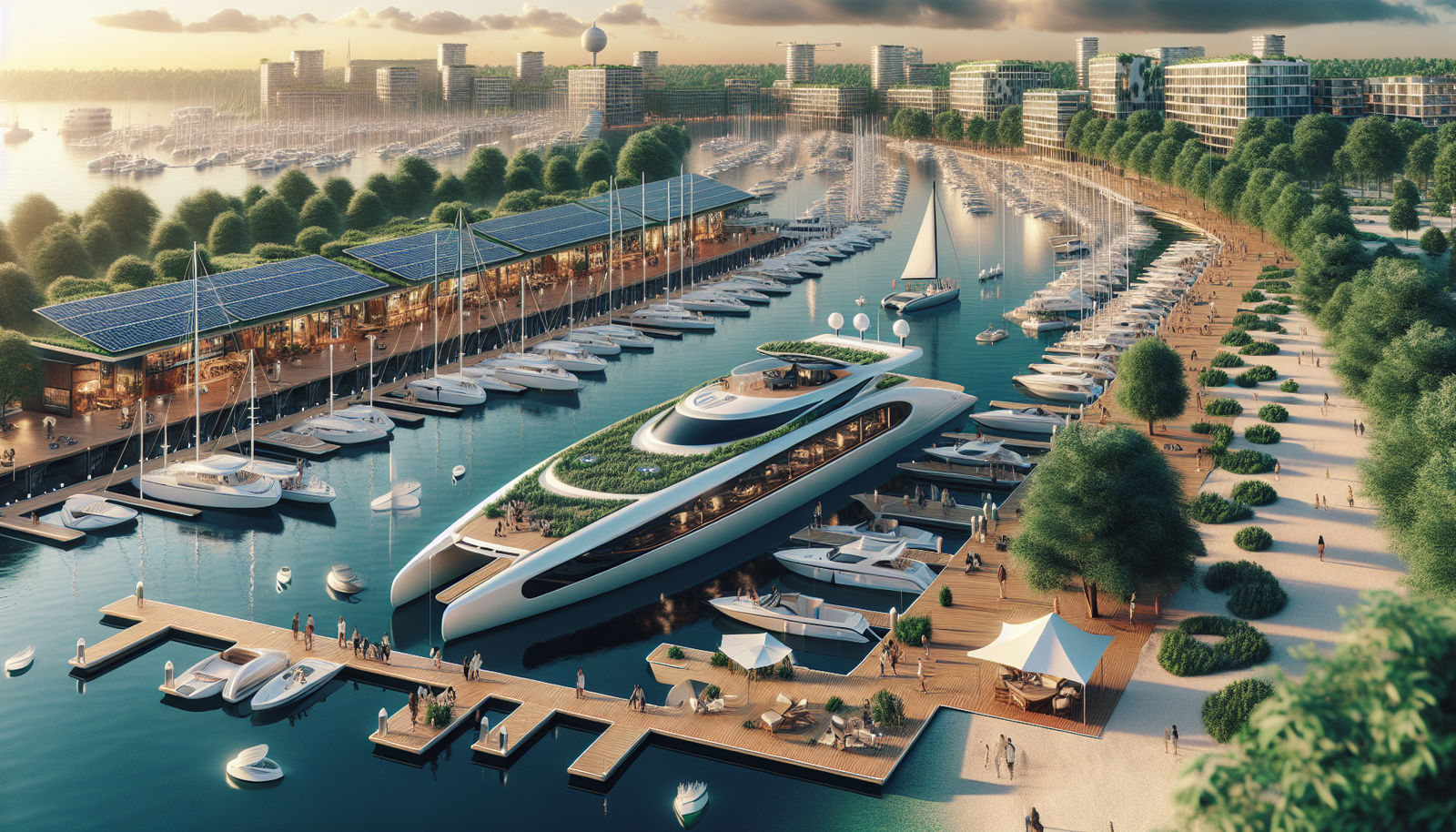Imagine gliding through tranquil waters in your fuel-efficient boat, knowing that your leisure time doesn’t come at a cost to the environment. It’s entirely within reach and it all starts with understanding the significance of eco-friendly boating infrastructures and facilities. This guide unlocks the scope of green boating with its fascinating features and benefits – steering you towards a world where nautical adventures coexist harmoniously with nature. From solar-powered docks to sewage disposal systems, learn about innovative methods that are making waves in the boating industry. “Eco-Friendly Boating Infrastructure and Facilities” is your roadmap to sustainable boating. Here’s to guilt-free getaways across the captivating blue expanse!

Understanding Eco-Friendly Boating
Eco-friendly boating refers to the approach and practices adopted to minimize the negative impacts of boating on the natural aquatic environment. It means the use of environmentally sustainable ways, from the design and construction of the boats to the conduct of boaters on the water.
Definition of Eco-Friendly Boating
In simpler terms, eco-friendly boating can be defined as a set of actions and behaviors that contribute to the protection and preservation of aquatic and shoreline environments. These actions cover a wide range of considerations, including the type of material used to build the boat, how it operates, the fuel it uses, how waste is managed, and the kind of maintenance it requires.
Importance and Benefits of Eco-Friendly Boating
As a recreational or commercial activity, boating has various environmental impacts. Adopting eco-friendly practices has numerous benefits. It helps to preserve aquatic life, reduce water and air pollution, conserve resources, and maintain the beauty of our natural water bodies. Importantly, it promotes long-term sustainability, ensuring that the delight of boating can be enjoyed by future generations.
Challenges of Eco-Friendly Boating
While the concept of eco-friendly boating offers many advantages, there are also several challenges. These include higher initial investment costs, limited availability of eco-friendly infrastructure or facilities, existing habits and attitudes of boaters, and the pace of technological innovations.
Eco-Friendly Design and Infrastructure in Marinas
Marinas are pivotal in supporting eco-friendly boating as they are the foundational infrastructure. They play a role in ensuring that the vessels and the activities around them are conducted in an environmentally friendly manner.
Eco-Friendly Building Materials
In designing eco-friendly marinas, the choice of building material is significant. These involve natural, renewable, and recycled materials that are durable, low maintenance and have minimal environmental impacts. Examples include using recycled plastic for dock construction or sustainably sourced hardwood.
Energy Efficient Designs
Energy efficient marina designs make use of natural light and ventilation as much as possible. Solar panels and wind turbines are incorporated to generate electricity and reduce reliance on grid energy. Equipment is chosen based on its energy efficiency rating.
Sustainable Dock Systems
The dock systems are not only designed to withstand harsh weather conditions but also to host flora and fauna, allowing them to connect with the natural environment in a sustainable way.
Stormwater Management
Stormwater run-off from marinas carries pollutants into the water bodies. Hence, features include permeable paving, rain gardens, and bioswales are incorporated in marina design to manage stormwater effectively.
Environmentally Friendly Boat Designs
Greener boats begin with the choice of materials and design. The focus is on lightweight, durable, and sustainable materials. Even the manufacturing process is optimized to reduce energy consumption and waste production.
Materials Used in Eco-Friendly Boat Building
Eco-friendly boat building materials compromise wood sourced from sustainable forests, bio-based resins, and recycled materials. The paint and finishes used are also low in toxic chemicals.
Design Considerations for Reduced Environmental Impact
Boats are designed to be fuel-efficient and to minimize noise pollution. They also have efficient waste management systems. The shape and weight of the boat come into play in reducing its impact on water and air.
Innovative Eco-Friendly Boat Designs
Boat designs are constantly evolving. Innovations include hybrid systems that combine solar, wind, and fossil fuels; electric propulsion systems; and hull designs that reduce drag and fuel consumption.

Eco-Friendly Boating Practices
Eco-friendly boating also involves the behavior and practices of individual boat owners and operators. Responsible actions at every step can make a huge difference in reducing the environmental footprint of boating.
Clean Boating Practices
Clean boating practices refer to minimizing the impact of boating on water quality. This includes avoiding littering, proper waste disposal, cleaning and maintaining the boat in a responsible way, and careful fueling to avoid spills.
Choosing Eco-Friendly Boat Fuels
Boat fuels contribute substantially to water and air pollution. Thus, choosing cleaner-burning fuels, using renewable energy sources like solar or wind wherever possible, and maintaining the engine for maximum fuel efficiency are some steps that can be taken.
Minimizing Noise and Air Pollution
Reducing engine noise and exhaust emissions are also part of eco-friendly boating practices. This could be by choosing quieter engines or using technical solutions to dampen noise. Good maintenance and tuning of the engine can help to minimize air pollution.
Disposal and Recycling of Boating Waste
Following regulations for disposal of waste, including sewage, garbage, and hazardous substances, is essential. Wherever possible, recycling should be the first choice.
Green Energy in Boating
The use of green energy is perhaps the most attractive part of eco-friendly boating. It not only reduces the carbon footprint but can also result in significant cost savings over the long run.
Use of Solar and Wind Power in Boating
Harnessing renewable energy is now feasible even on small boats using solar panels or wind turbines. These can provide electricity for lights, navigation systems, and other onboard equipment, reducing the need for fossil fuel-generated power.
Hydrogen and Electrical Powered Boats
Hydrogen fuel cells and electric motors are two emerging technologies in boating. Although at a nascent stage, their potential in reducing pollution and reliance on fossil fuels is considerable.
Battery Technology in Boating
Advances in battery technology are making electric boats a practical reality. This is a rapidly evolving field and one to watch for the future.
Water Conservation in Boating Facilities
An integral part of eco-friendly boating and marina infrastructure involves effective water conservation and management.
Effective Use of Grey Water
Grey water, which is non-sewage waste water, can be reused in many ways, such as for irrigation, flushing toilets, or washing boats.
Water Recycling Systems
Installing water recycling systems like reverse osmosis or rainwater harvesting can reduce the freshwater demand of marinas and boating facilities.
Rainwater Harvesting in Marinas
Collecting and storing rainwater for future use is a smart way for marinas to conserve water and reduce water costs.
Waste Management in Boating
Proper waste management on boats and at marinas is critical to eco-friendly boating.
Managing Solid Waste in Boating
This involves promoting a “leave no trace” mindset among boaters, waste segregation on boats, and providing proper waste disposal facilities at marinas.
Managing Sewage and Grey Water in Boating
Boats equipped with onboard toilets should have systems to treat or store sewage until it can be properly disposed of. Management of grey water should also be part of the boat design, as it can significantly contribute to water pollution.
Recyclable Materials and Reusing in Boating
Using recyclable materials in boat construction and encouraging the reuse of items can help to reduce the waste generated through boating.
Education and Awareness for Eco-friendly Boating
Promotion of eco-friendly boating principles and practices often starts with education and fostering awareness.
Promoting Environmental Stewardship among Boaters
Encouraging a sense of responsibility towards the environment can inspire boaters to adopt more sustainable practices. Environmental stewardship can be promoted through signs, brochures, workshops, and other modes of communication.
Training and Certifications for Eco-friendly Boating
Training programs and certifications for eco-friendly boating can reinforce this knowledge and provide an impetus for more boaters to get on board the green boating movement.
Role of Government and Regulatory Bodies
Regulatory bodies can play a significant part in supporting eco-friendly boating by implementing relevant policies, funding research into green boating technologies, and incentivizing eco-friendly practices.
Technological Innovations for Eco-friendly Boating
Technology has a significant role to play in the evolution of green boating.
Innovations in Boat Design
Innovations in boat design such as hydrofoil technology, hybrid propulsion systems, and lightweight, durable materials are paving the way for more efficient and sustainable boats.
Innovations in Boating Infrastructure
Technology is also revolutionizing marina infrastructure, with intelligent docking systems, energy-efficient equipment, and smart waste management solutions.
Impact of Digital Technology on Eco-Friendly Boating
Digital technology is also making a mark on the boating industry. Various apps can help boaters to find the nearest fueling or waste disposal stations, monitor their boat’s fuel efficiency, and provide data to help in making eco-friendly choices.
Case Studies of Eco-Friendly Boating Infrastructure
It’s always inspiring to see the concepts of eco-friendly boating being applied in the real world.
Eco-friendly Marinas around the World
There are several examples of marinas around the globe that are committed to sustainable practices. These range from small private marinas to large commercial operations.
Success Stories of Environmentally Friendly Boat Designs
Several boat manufacturers and designers are now focusing on creating eco-friendly boats. Many of these designs have proven a success, both in terms of environmental impact and user experience.
Examples of Effective Waste Management in Boating
Many boating communities and marinas have initiated effective waste management programs, setting an example for others to follow.
In conclusion, eco-friendly boating holds the key to preserving our precious water bodies while ensuring we continue to enjoy the pleasures of being on the water. Embracing technological innovations, practicing responsible boating, creating sustainable marinas, and fostering awareness and education can lead us towards this noble goal. It’s a journey worth embarking on, for the sake of our planet and for all its inhabitants that call it home.


[…] the blues, have you ever considered the environmental impact of your favorite pastime? “eco-friendly boating Travel Tips and Strategies” is your definitive guide to ensure your boating experience […]